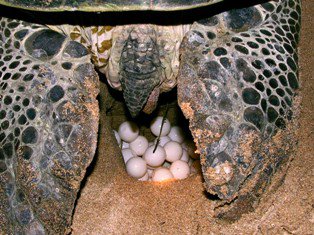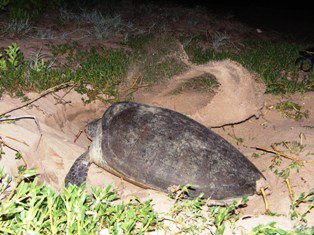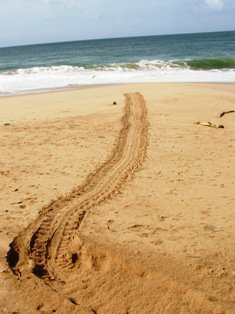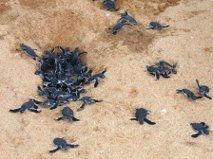Giant green sea turtles laying eggs in Sri Lanka

REKAWA, Sri Lanka — I am normally a lousy target for street hustling. My street instincts are pretty accurate. Through 37 years of international travel, I can tell when a “special price” isn’t special, when a “tour” is short for “tourist trap.” The last time I trusted a cab driver was in 1997 in Rio when I, lonely and single, asked the driver for a good place to meet local women.
He took me to a brothel. (And the answer to your next question is NO.)
Last night I trusted a cab driver. I didn’t go to a brothel. I doubt Sri Lanka has them. Instead, I had one of the great wildlife experiences of my life. I saw giant green sea turtles laying eggs.
I wanted out of Goyambokka for my last night so I had the tuktuk driver take me into neighboring Tangalle. I needed flipflops after high tide swept my $2 Target specials out to sea and a sarong to use as a beach towel when I hit my next beach in India. His name was Marish and between stores he immediately launched into a sales pitch.
“This week is the first week of turtle season,” he said, yelling over his shoulder as he careened around holes in the road, stray dogs and other tuktuks doing the same. “It lasts for three months. Do you want to see turtles laying eggs?”

I casually asked how much.
“To take you down all the way past Tangalle, to drop you at the beach, to wait for you and take you back,” he said as I waited for a larcenous price after his big buildup, “is 1,600 rupees.”
That’s $12. Really? To see turtles nesting?
When I returned from the best meal in Sri Lanka at a weird souvenir shop/restaurant called Chalet, I asked my helpful guesthouse manager at Rocky Point if you can really see turtles nesting.
“Yes,” he said. “But you’d better hurry. If you go now, you’ll be there by 9. It ends at about 10. What price did you get?”
“Sixteen hundred.”
“Good price.”
So I had him call Mareesh who immediately left his wife and child at dinner and raced down. The 1,600 was a ripoff — to him. The beach site where the turtles nest is in Rekawa, about 15 kilometers on the other side of Tangalle. We crossed the bridge into Tangalle and I wanted desperately to stop and shoot the full moon sticking up between two giant palm trees bordering the murderous coast. This was where the 2004 tsunami swept a kilometer onto shore and killed 500 residents. It pulled them right from their homes and swept them out to sea.
We couldn’t waste time and I could tell by Mareesh’s driving. The stray dogs littering the roads made turning acumen paramount.
“Some of them sleep in the middle of the road,” he said. “You have to be careful not to kill them.”
We turned onto a dirt road and careened through a mangrove forest past old men wearing the Hindu sarong. I could see little fires in homes where people were eating. We passed one hotel, the Buckingham Palace, owned by a Brit right on the beach.
We finally came to a small single-story structure serving as an information center. A stern man in a moustache greeted us — along with about two dozen other tuktuks. We were not alone. This must be legit. I paid the 1,000-rupee fee and a volunteer took me outside, down a path onto the broad beach. The night could not have been more beautiful if Monet had painted it.
The moon I last saw at the Tangalle bridge reappeared over a cluster of palm trees. It flickered off the ocean which delicately lapped against the beach. We walked for about 10 minutes where, in the dark, I could see the shadows of about 40 people. Even in the dark, I could tell they were tourists. Stark white legs and matching shorts tend to shine in moonlight.

A pretty, diminutive Sri Lankan in her 20s wearing a Turtle Conservation Project T-shirt gave me a brief description of their operation.
Sea turtles are endangered in Sri Lanka, as well as around the world, but thanks to the Turtle Conservation Project, a non-profit organization started in 1993 to “Make Sri Lankan Seas a Heavenly Habitat For Turtles,” effort is there. It starts with these grounds where tourists are allowed to watch but the turtles are heavily protected. Flash photography is not allowed.
The turtles lay eggs three times a year but never more than seven times in a lifetime. They lay up to 200 eggs at a time, necessary since only about one baby turtle in 1,000 survives the dogs, bird and sharks that feed on them like Jujubes. Curiously, the mother turtles come to the same spot on the beach every time.
I thanked her profusely and walked another 10 minutes with the mob. Near an outcropping of brush, well away from the tide, three or four male volunteers were pointing to a hole under what looked like a giant rock. I could see inside a glistening white ball. It was an egg, a turtle egg she had just laid. I asked if the turtle was in that hole. It turned out to be one of the five dumbest questions of my travel writing career. He pointed straight.

The mother turtle was the rock. I was staring at its huge shell. The turtle must’ve been five feet long. Her powerful back legs dug into the sand. It was motionless. Her eyes sagged. No wonder. How would you like to give birth 200 times standing up?
A few feet away, a group gathered around another turtle. A volunteer shined an infrared light under her. She had a short, fat white tube-like organ hanging down from her a few inches off the ground. Then they came. Little glistening eggs, still shiny from her insides, plopped down on the ground like Glo-Balls off a conveyor belt. Out came one. Then two. Then three. They do this for about two hours until they’ve disgorged 1,000.
Mother Nature, you did it again. I’m still emotionally scarred by the filmed childbirth I saw in high school health class. That’s not the reason I don’t have children but I can’t deny it didn’t contribute.

But the birth process of any mammal is remarkable and in the animal kingdom it’s shocking how everything works in unison. The turtles find the same spot, they dig a hole, the eggs come out. The turtles were expressionless. Few animals in my lifetime have shown less joy than a turtle. Even in the water scuba diving, I’ve noticed they always seem to be escaping something.
But these seemed content in their motherhood. When they finished disgorging eggs, which formed a small mountain under them, they used their huge, powerful back flippers to cover the eggs with sand. There they will remain for two months before they hatch and try to stay alive for more than a few desperate minutes. A volunteer showed me a video of the baby turtles making a wild scramble to the sea. Their flippers were bigger than their bodies. They seemed to flop down the beach, kind of like baby penguins. It’s frightening to think that those few minutes are often the only life they will ever know before some seagull picks them up for his evening aperitivo.
Soon the mother turtles dug out of their hole and crawled slowly to the beach. Before reaching the water they stopped. What were they doing? Did they changed their minds? Do they not want to leave their babies?
We all watched intensely. Then the waves started to reach them. Then they started to cover them. The water would recede and the turtles would remain. Finally, a big tide came in, covering the turtles for about 10 seconds.
When the tide returned, so did the turtles. They were gone.


April 6, 2015 @ 8:41 am
We have swum with sea turtles, and that too is magical. Wonderful that Sri Lanka is doing such a good conservation job. Now if we could just keep plastics out of the seas…
April 6, 2015 @ 10:25 am
Thanks for the comment. Blame the tour boats for the ocean trash. Much of it is swept off the decks and wash ashore.